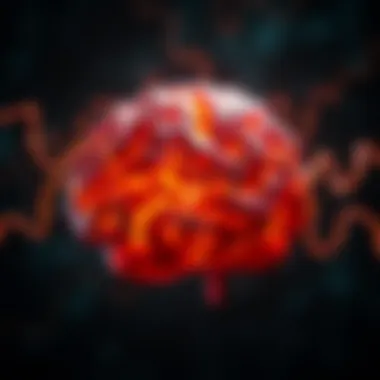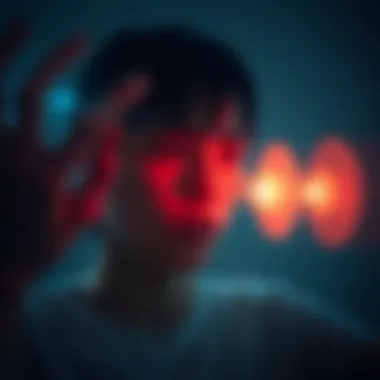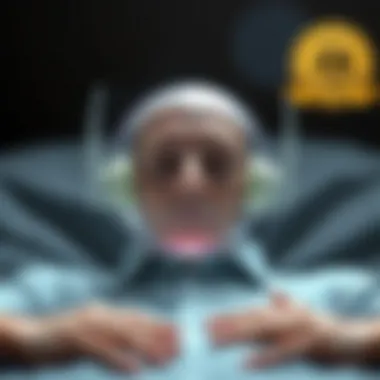Exploring Auditory Hallucinations in Schizophrenia


Intro
Auditory hallucinations are a hallmark of schizophrenia, weaving a complex tapestry of perception and experience that can deeply affect those who live with this illness. These hallucinations manifest as hearing voices or sounds that aren't present in the external environment, often leading to confusion and distress. Understanding how these auditory experiences shape the lives of individuals with schizophrenia is crucial for effective treatment and support.
In recent years, the scientific community has made strides in uncovering the underlying mechanisms of auditory hallucinations. Research has explored whether these occurrences are more like an unending barrage of voices or sporadic interruptions in a person’s daily life. The nature of these experiences can greatly influence the patients' interactions with the world around them. Some researchers argue that auditory hallucinations are a reflection of intricate cognitive processes and emotional states, while others delve into the neurological pathways that may be disrupted in people with schizophrenia.
As we examine the multifaceted nature of auditory hallucinations, we will dissect experiences that vary from person to person, considering factors such as duration, frequency, and the personal significance of the voices heard. This exploration aims to offer a clearer understanding of how these auditory phenomena affect the lived experience of individuals diagnosed with schizophrenia, while also examining potential management strategies based on current research insights.
Through this narrative, we will lay a foundation that not only outlines key findings but also delves into implications for real-world applications and future research endeavors. With every step of our journey, we will seek to amplify the voices of those who experience these auditory phenomena, ensuring that their stories inform ongoing discussions and explorations.
In short, gaining a comprehensive understanding of auditory hallucinations in schizophrenia goes beyond academic interest; it can lead to improved patient outcomes and quality of life, providing a pathway for empathy and support in a field often shrouded in misunderstanding.
Defining Schizophrenia
Defining schizophrenia is a crucial part of comprehending auditory hallucinations. This kind of mental disorder doesn't just pop up overnight; it requires a nuanced understanding of its symptoms and types. By grasping what schizophrenia truly entails, we can better appreciate how auditory hallucinations manifest and affect those diagnosed with the condition. It's not simply about recognizing symptoms; it's about understanding the unique experiences faced by individuals, which lays the groundwork for meaningful dialogue about treatment and empathy.
Overview of Schizophrenia
Schizophrenia is exceedingly complex, often characterized by alterations in thinking, perception, emotions, and behavior. People with this mental disorder might find themselves in a world that feels ever so slightly askew; colors are more vivid, sounds are sharper, and voices seem to echo where silence should reign. This distortion can lead to severe disruptions in daily life. Signs typically surface in late adolescence or early adulthood, and while estimating prevalence can be tricky, it's believed that around 1% of the global population suffers from some form of schizophrenia.
A common misconception is that one might equate schizophrenia with multiple personality disorder. This isn't the case. Schizophrenia is about a fractured sense of reality, not a fragmented identity. Viewing it through this lens enables a clearer understanding of the intricate tapestry that comprises the lives of those afflicted.
Symptoms and Types
The symptoms of schizophrenia vary from one person to another, and they can generally be grouped into three categories: positive, negative, and cognitive symptoms.
- Positive symptoms include hallucinations, delusions, and thought disorders. In particular, auditory hallucinations — the focus of this article — belong here. It’s not uncommon for individuals to hear voices that comment on their behavior or even converse with them.
- Negative symptoms often refer to a lack of motivation, limited emotional expression, and difficulties in social interactions. Imagine the experience of feeling a constant heaviness; even everyday tasks can feel monumental.
- Cognitive symptoms can affect memory, attention, and the ability to process information. This type plays a crucial role in how patients navigate life.
To further delineate the disorder, it can be categorized into different types such as paranoid, disorganized, and catatonic schizophrenia, each presenting its unique set of attributes and challenges. Understanding these differences sheds light on why auditory hallucinations might present as they do in different individuals.
In summary, recognizing and defining schizophrenia isn’t merely a gateway to discussing auditory hallucinations; it’s a fundamental piece of a larger puzzle. For students, researchers, and professionals alike, engaging with these aspects establishes a solid foundation for further exploration into the experience of those living with schizophrenia.
Auditory Hallucinations Explained
Auditory hallucinations, often perceived through the lens of schizophrenia, are a critical aspect of understanding this mental health condition. Grasping the nature and implications of these experiences helps frame discussions about schizophrenia itself. It sheds light on the lived experiences of individuals, paving the way for better support mechanisms. The importance of this topic lies not just in clinical observation, but in appreciating how such phenomena can deeply affect functionality and quality of life. Were they mere whispers or loud proclamations, the significance of how auditory hallucinations are perceived can’t be overstated; they are fundamental to the daily challenges faced by many.
What are Auditory Hallucinations?
Auditory hallucinations refer to hearing sounds, voices, or noises that aren’t present in reality. It’s like having the sound of a phantom radio blaring in your mind, but the station is one nobody else can tune into. These can range from indistinct murmurs to clear speech, and can be quite distressing. The voices might comment on the individual’s actions, providing commentary that spans the spectrum from neutral to derogatory.
Some people describe these voices as distinctly external, almost as if they come from outside one’s head. In contrast, others may feel as if the voices are internal dialogues. Research often illustrates the diverse character of these perceptions; distilling down to subjective experience highlights the necessity for tailored treatment options. Also, it’s crucial to understand that not everyone diagnosed with schizophrenia experiences these hallucinations in the same way or frequency.
Prevalence in Schizophrenia
Auditory hallucinations are prevalent among individuals diagnosed with schizophrenia, with various studies suggesting that about 70% of patients experience them at some point in their lives. This substantial number highlights a major symptom that is intertwined with the disorder’s overall impact. Not every individual hears voices perpetually; the nature of such experiences can manifest differently over time. Each patient may have a unique narrative concerning the volume, frequency, and context of their hallucinations.


It’s essential to recognize that prevalence does not imply uniformity. Some individuals might hear voices daily while others might only experience them infrequently. From personal anecdotes shared in forums like reddit.com, it’s apparent that many people find comfort and solidarity in discussing their experiences with auditory hallucinations, contributing to a broader understanding of the disorder.
"Experiencing auditory hallucinations can feel like being trapped in a loud room where everyone’s talking but no one is listening. It’s isolating yet ubiquitous in its presence."
The relevance of studying these auditory phenomena cannot be stressed enough. Understanding varied prevalence among the patients allows for better individualized approaches in treatment strategies, embracing the complexity of what it means to live with schizophrenia. As we explore this further, consider how cultural context and environment might also shape the experiences related to auditory hallucinations.
Do Schizophrenics Hear Voices All the Time?
The question of whether individuals with schizophrenia hear voices continuously or intermittently is pivotal in understanding the impact of auditory hallucinations on their lives. This section will delve into the specifics of frequency and duration, as well as the variability in these experiences among those diagnosed with schizophrenia. Understanding these elements is essential, as they play a critical role in how auditory hallucinations are perceived, managed, and treated.
Understanding Frequency and Duration
When discussing auditory hallucinations in schizophrenia, frequency and duration are not just numbers; they embody a range of experiences that shape daily life. Most people with schizophrenia do not hear voices constantly. In fact, varying studies indicate that the occurrence can often show significant fluctuation. Some might hear voices sporadically, while for others, it can feel like a near-constant presence.
For instance, a patient named John might report hearing voices intensively during stressful periods like family gatherings but hardly at all during quieter times alone at home. This variability suggests that triggers play a critical role. Research points out that elements such as stress, environment, and emotional states can enhance or dampen the volume of these auditory situations.
The duration of these hallucinations can also differ markedly. Some experiences last mere seconds and vanish as swiftly as they appeared, while others might linger for hours, creating a persistent backdrop to one’s thoughts. This inconsistency underlines the complexity of the condition, highlighting that auditory hallucinations function somewhat like weather patterns—unpredictable and often influenced by external factors.
Auditory hallucinations vary significantly not only in frequency but also in their emotional weight and context, affecting how one copes with their reality.
Variability of Experiences
The term ‘variability’ aptly describes how not all individuals with schizophrenia will share the same auditory experiences. Each person has a unique story shaped by their personality, past experiences, and environment. For some, voices might be hostile, adding a layer of distress to their everyday life. For others, the voices could be benign or even comforting, leading to very different coping strategies.
Cultural factors also come into play. In societies where spiritual experiences are more accepted, individuals might view their voices as entities with meaning and purpose. In contrast, in more skeptical environments, such voices might be pathologized, increasing the stigma and personal struggle associated with them.
The social circle surrounding an individual also greatly influences their experiences. Support networks can alter how one perceives and reacts to hallucinations. A close friend might help an individual rationalize or dismiss transient thoughts, while isolation could amplify their distress.
Mechanisms Behind Auditory Hallucinations
The mechanisms behind auditory hallucinations represent a critical aspect of understanding this complex phenomenon in schizophrenia. An insightful exploration into these mechanisms not only sheds light on the experiences of those affected but also helps refine treatment options and therapeutic approaches. Auditory hallucinations are not simply by-products of other symptoms; they stem from specific neurological and psychological processes that intertwine uniquely in each individual.
Neurological Basis
To grasp the underpinnings of auditory hallucinations, one must delve into the brain’s wiring. The auditory cortex, responsible for processing sounds, plays a vital role here. During episodes of hallucination, studies have indicated that this region is often more active than what would be seen in normal auditory processing. Such heightened activity can be a reflection of the brain trying to make sense of internal stimuli, leading to perceptions where there are none externally.
Additionally, the connections to areas involved in language processing, like Broca’s area, further complicate the matter. This area has been linked to verbal commands or inner speech, suggesting that some individuals may confuse their own thoughts for external voices. The harmony—or disharmony—of these networks is paramount in understanding the individual’s experiences, as variations in brain structure and function can influence the type and intensity of the auditory hallucinations a person may perceive.
"Hallucinations can be seen as the brain's attempt to fill in gaps in perception, guiding individuals to interpret their experiences uniquely."
Psychological Factors
Moving beyond the neural framework, psychological factors undeniably shape the experience of auditory hallucinations. Environmental influences, including stress and trauma, can exacerbate these occurrences, illustrating the powerful interplay between external factors and mental health. Cultural aspects also color how individuals interpret and react to their hallucinations. For instance, in cultures where hearing voices is viewed as a spiritual experience, individuals may approach the phenomenon with a different mindset, potentially leading to less distress.
Cognitive theories provide further insight into how a person’s thoughts and beliefs can influence their experiences. For instance, if someone believes these voices are malevolent, their distress may amplify, creating a vicious cycle. Conversely, individuals who reframe these voices as benign or even supportive may find ways to cope more effectively.
In summary, understanding the mechanisms behind auditory hallucinations unveils a rich tapestry formed from the neurological to the psychological. Each thread contributes to the overall experience of schizophrenia, highlighting the relevance of tailored intervention strategies that consider both sides of this intricate interaction.


Individual Differences in Experience
The individual variances in how auditory hallucinations manifest in people with schizophrenia are critical to grasping this complex phenomenon. These differences can shape not only the distress associated with the experiences but also the effectiveness of treatment strategies. The notion that no two individuals experience hallucinations in the exact same way is fundamental to understanding the broader implications on mental health management. This section will shed light on how personal backgrounds and coping mechanisms can influence the auditory experience in schizophrenia, ultimately informing tailored therapeutic approaches.
Influence of Environment
Cultural Factors
Cultural factors play a significant role in shaping the experiences of auditory hallucinations among patients diagnosed with schizophrenia. In various cultures, the interpretation of voices can differ remarkably. For instance, in some societies, hearing voices might be perceived as a spiritual experience or a sign of being chosen for a higher purpose, rather than a symptom of a mental illness. This perspective can notably influence how individuals react to their hallucinations, sometimes leading to less stigma and a greater sense of community support.
One key characteristic of cultural factors is that they provide a narrative frame through which individuals make sense of their experiences. This is beneficial because it can foster acceptance and resilience, allowing patients to navigate their hallucinations more effectively.
However, a unique feature of cultural interpretation can be the potential risk of dismissing the need for medical intervention. If voices are viewed through a spiritual lens, some might avoid treatment, which may lead to deterioration in mental health. This cultural context highlights the advantage of understanding a patient's background when developing treatment plans.
Social Interactions
Social interactions are another pivotal aspect that influence how auditory hallucinations are experienced. Support systems can greatly shape a patient’s understanding of their condition and their coping strategies. Positive social interactions, such as supportive friends and family who validate the individual’s experience, can help manage the distress caused by hallucinations.
The key characteristic of social interactions is their potential to create a buffer against the negative impacts of hallucinations. When individuals feel connected and supported, they may process their hallucinations with less anxiety, which can lead to improved mental health outcomes.
Nevertheless, the unique feature of social dynamics can also lead to challenges. Not all interactions are supportive; negative feedback or misunderstanding from peers can exacerbate feelings of isolation and fear. Thus, it becomes clear that the quality of social interactions can either serve as a protective factor or a risk factor in managing auditory hallucinations.
Coping Mechanisms
Personal Strategies
Addressing the personal strategies one adopts to cope with auditory hallucinations is essential for enhancing one’s quality of life. Individuals often develop a range of techniques tailored to their unique experiences. For example, some may engage in grounding techniques like mindfulness or focus on their breathing to redirect attention from the intrusive voices. A key characteristic of personal strategies is their adaptability, allowing for a fitting response to varied situations. This flexibility is beneficial because it empowers individuals, giving them a sense of control over their experiences.
However, a notable pitfall is the potential for reliance on less effective strategies. If individuals gravitate toward avoidance or denial, they may miss opportunities for meaningful engagement with therapeutic options available. Thus, it’s crucial to support patients in identifying and fostering effective coping mechanisms that enhance well-being.
Therapeutic Interventions
Therapeutic interventions represent a cornerstone in addressing auditory hallucinations. These can include not just medication, but also therapies like Cognitive Behavioral Therapy (CBT) specifically tailored for schizophrenia. The central aspect of therapeutic interventions is their evidence-based nature, designed to reduce the severity and impact of hallucinations. This structured approach is popular due to its focus on skill-building and personal empowerment.
A unique feature of therapeutic interventions is their adaptability to individual needs, which can significantly enhance treatment adherence and effectiveness. However, challenges such as access to quality care and potential side effects of medication exist. It's crucial for clinicians to engage with patients to find an approach that resonates personally, promoting a collaborative effort toward managing auditory hallucinations.
Clinical Implications of Auditory Hallucinations
Auditory hallucinations, a hallmark of schizophrenia, have far-reaching clinical implications. Understanding these implications is vital for both healthcare providers and patients. Recognizing the nature and impact of auditory hallucinations helps in tailoring treatment plans, improving patient outcomes, and enhancing the overall quality of life for affected individuals.
These hallucinations often hinder daily functionality. Patients may find it challenging to engage in work, maintain relationships, or perform routine tasks. This can lead to further isolation and exacerbate symptoms. Therefore, addressing auditory hallucinations is not just about managing the voices; it’s about restoring the ability to navigate life effectively.
Impact on Functionality
The impact of auditory hallucinations on functionality can be profound. They may influence a patient's ability to concentrate or engage in conversations. For instance, someone hearing voices that comment on their behavior may feel constantly scrutinized, making it difficult to focus on tasks at hand. In social settings, the distraction caused by these voices can isolate individuals from their peers, leading to a cycle of withdrawal and depressive symptoms.


Walking in a bustling street, one might imagine a person murmuring incessantly about their actions. This feeling may provoke anxiety or unease, further limiting their interactions with others. As a result, understanding how these experiences shape daily life is pivotal for caregivers, families, and mental health professionals. Adjusting treatment approaches to mitigate these effects can significantly improve a patient's functionality.
Treatment Approaches
When it comes to treating auditory hallucinations, a dual approach often yields the best results: pharmacological treatments and psychotherapy techniques. Each has unique advantages and can be tailored to individual patient needs.
Pharmacological Treatments
Pharmacological treatments focus on the use of medications to manage symptoms of schizophrenia, including auditory hallucinations. Antipsychotic drugs such as clozapine or risperidone have become staples in this realm. These medications work by altering neurotransmitter activity in the brain, particularly dopamine pathways, which are believed to play a significant role in hallucinations.
One key characteristic of pharmacological treatments is their potential to diminish the intensity and frequency of hallucinations. This can have a profound impact on daily living, allowing patients to manage their symptoms more effectively. However, it's crucial to note that while these medications can be life-changing, they often come with side effects, such as weight gain or sedation, that may complicate treatment.
"Medications are a vital cog in the wheel of symptom management, but understanding each patient's unique response is paramount."
Psychotherapy Techniques
Psychotherapy, particularly cognitive behavioral therapy (CBT), serves as a crucial counterpart to pharmacological methods. This approach helps patients develop coping strategies for dealing with the distress associated with their hallucinations. Techniques in CBT might involve reframing negative thoughts related to the voices, ultimately enabling patients to gain more control over their experiences.
A notable strength of psychotherapy is its focus on the individual’s thought patterns and emotional responses, fostering empowerment through understanding. Unlike pharmacological treatments, which may address the symptoms superficially, psychotherapy dives deeper into the subjective experience, which can be transformative.
Still, it's essential to recognize the limitations. Some patients may find it challenging to engage with therapy due to the overwhelming nature of their hallucinations, emphasizing the need for an integrated treatment approach.
Together, these treatment modalities represent a comprehensive strategy for addressing auditory hallucinations in schizophrenia. By acknowledging their clinical implications, we can work towards more effective interventions that ultimately enhance the quality of life for those who experience them.
Research Directions and Future Perspectives
The ongoing exploration of auditory hallucinations in individuals diagnosed with schizophrenia is a vital area within mental health research. As scientists delve deeper into the intricacies of this phenomenon, emerging theories and technological advancements pave the way for new understanding and, ultimately, better management strategies. The implications of this research not only enhance the comprehension of the experiences faced by patients but also point toward potential therapeutic interventions that can make a tangible difference in their lives.
Emerging Theories
Recent studies are painting a more dynamic picture of auditory hallucinations. It's not just about hearing voices; researchers are starting to look more closely at the context in which these experiences occur. For instance, theories suggest that voices might be a manifestation of a broader cognitive and emotional landscape, rather than isolated auditory occurrences. This brings to light the idea that a person's emotional state, past traumas, and even their social environment can significantly influence the nature of these hallucinations.
Some emerging theories also propose a connection between auditory hallucinations and the brain’s processing of self-referential information. The voices might be misattributed internal thoughts, which indicates that a person may hear their own thoughts being vocalized as if they were separate entities. This theory posits that the boundaries of self versus other are blurred, warranting further investigation into self-perception in schizophrenia.
Technological Advancements in Research
Technology is playing an increasingly crucial role in unraveling the complexities of auditory hallucinations. Functional neuroimaging, like fMRI and PET scans, allows researchers to visualize brain activity in real-time. This provides insights into which areas of the brain are activated when a person hears voices, illuminating the neurological underpinnings of this experience.
Moreover, advancements in artificial intelligence and machine learning are shaping the landscape of psychological research. These technologies can analyze vast amounts of data ranging from patient histories to neuroimaging results, identifying patterns that may not be obvious to human researchers. Such analysis can potentially refine treatment options or predict the likelihood of auditory hallucinations based on individual profiles.
Culmination and Summary of Findings
In reviewing auditory hallucinations within the context of schizophrenia, we must emphasize how vital this topic is. Not only does it encapsulate the core experience of many patients, it also highlights the diverse spectrum of human perception. Understanding auditory hallucinations can enlighten various stakeholders including clinicians, families, and the patients themselves about the nuances of this condition. They are not just medical symptoms but lived experiences that profoundly affect individuals' daily lives.
Key Takeaways
- Nature of Hallucinations: Auditory hallucinations often manifest as voices or sounds, which can be critical in understanding patients' realities. It is not merely a question of 'hearing voices' but delving into the content and emotional significance these voices hold.
- Variability in Experience: Individual responses to these hallucinations can vary widely based on numerous factors such as cultural background, personal experiences, and environmental influences. This variability challenges the simplistic views often held about schizophrenia, urging a more nuanced understanding.
- Impact on Daily Functioning: The implications of auditory hallucinations are far-reaching, affecting relationships, employment, and overall quality of life. Recognizing the broader context of these experiences can guide better support systems.
- Management Strategies: Effective management is multifaceted, involving pharmacological treatments and psychological support. Personalized approaches tailored to individual experiences often yield the best results.
Final Thoughts on Auditory Hallucinations
"Recognizing the variety and seriousness of auditory hallucinations is essential in crafting compassionate care strategies and enhancing the quality of life for individuals living with schizophrenia."
The journey to comprehend these phenomena is ongoing, and it's essential to keep the discourse alive within academic and clinical communities, ensuring that every voice—literal or metaphorical—finds a place in our understanding.







